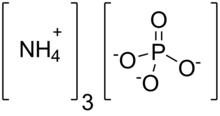Ammonium phosphate

| |

| |
| Names | |
|---|---|
| IUPAC name
ammonium phosphate
| |
| Other names
triammonium phosphate
| |
| Identifiers | |
3D model (JSmol)
|
|
| ChemSpider | |
| ECHA InfoCard | 100.030.709 |
| EC Number |
|
PubChem CID
|
|
| UNII | |
CompTox Dashboard (EPA)
|
|
| |
| |
| Properties | |
| (NH4)3PO4 | |
| Molar mass | 149 g/mol |
| Appearance | White, tetrahedral crystals |
| 58.0 g/100 mL (25 °C) | |
| Hazards | |
| GHS labelling: | |

| |
| Warning | |
| H302, H319 | |
| P264, P270, P280, P301+P312, P305+P351+P338, P330, P337+P313, P501 | |
| NFPA 704 (fire diamond) | |
| Thermochemistry | |
Std enthalpy of
formation (ΔfH⦵298) |
−1671.9 kJ/mol |
| Related compounds | |
Other cations
|
Trisodium phosphate Tripotassium phosphate |
Related compounds
|
Diammonium phosphate Monoammonium phosphate |
Except where otherwise noted, data are given for materials in their standard state (at 25 °C [77 °F], 100 kPa).
| |
Ammonium phosphate is the salt of ammonium and phosphate. It is a highly unstable compound with the formula (NH4)3PO4. Because of its instability, it is elusive and of no commercial value. A related "double salt", (NH4)3PO4.(NH4)2HPO4 is also recognized but is too unstable for practical use. Both triammonium salts evolve ammonia. In contrast to the fragile nature of the triammonium salts, diammonium phosphate (NH4)2HPO4 is a valuable material, mainly as a fertilizer. Also of value is monoammonium salt (NH4)H2PO4 which is also valued as a fertilizer. These two salts provide plants with fixed nitrogen and phosphorus.[2]
Preparation of triammonium phosphate
Triammonium phosphate can be prepared in the laboratory by treating 85% phosphoric acid with 30% ammonia solution:[3]
- H3PO4 + 3 NH3 → (NH4)3PO4
(NH4)3PO4 is a colorless, crystalline solid. The solid, which has the odor of ammonia, is readily soluble in water. The salt converts to diammonium hydrogen (NH4)2HPO4.
Preparation of diammonium hydrogen phosphate (DAP)
DAP is a simple salt and a complex fertilizer.[4][5] It is also the source of nitrogen and phosphorus nutrients.[4][5]
- H3PO4 + 2 NH3 → (NH4)2HPO4
On heating, (NH4)2 HPO4 evolves ammonia, giving colorless crystals of the monoammonium salt.
(NH4)2 HPO4 is a colorless, odorless, crystalline solid, which insoluble in water.[4]
See also
References
- ^ Lide, David R. (1998). Handbook of Chemistry and Physics (87 ed.). Boca Raton, Florida: CRC Press. pp. 4–42, 5–19. ISBN 0-8493-0594-2.
- ^ Klaus Schrödter, Gerhard Bettermann, Thomas Staffel, Friedrich Wahl, Thomas Klein, Thomas Hofmann "Phosphoric Acid and Phosphates" in Ullmann’s Encyclopedia of Industrial Chemistry 2008, Wiley-VCH, Weinheim. doi:10.1002/14356007.a19_465.pub3
- ^ Smith, R. J.; Bryant, R. G. (1975-10-27). "Metal substitutions incarbonic anhydrase: a halide ion probe study". Biochemical and Biophysical Research Communications. 66 (4): 1281–1286. ISSN 0006-291X. PMID 3.
- ^ a b c Benckiser, R. http://www.rsc.org/learn-chemistry/resource/download/res00000903/cmp00001145/pdf.
{{cite web}}: Cite has empty unknown parameter:|dead-url=(help); Missing or empty|title=(help) - ^ a b Ross, Wm. H.; Merz, Albert R.; Jacob, K. D. (March 1929). "Preparation and Properties of the Ammonium Phosphates". Industrial & Engineering Chemistry. 21 (3): 286–289. doi:10.1021/ie50231a029. ISSN 0019-7866.

